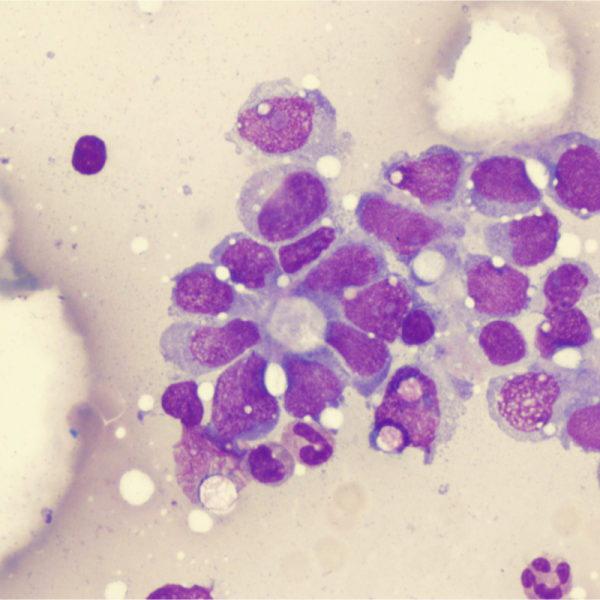
What is Ewing's sarcoma?
Ewing's sarcoma is an extremely malignant form of bone cancer (highly malignant), which occurs particularly frequently in children and adolescents up to the age of 15 and is the second most common malignant bone cancer in this group, followed by osteosarcoma. Boys develop Ewing's sarcoma more often than girls. In 60 per cent of all cases, the medullary cavity of large tubular bones (diaphysis) is particularly affected. More rarely, Ewing's sarcoma also develops in the pelvis (18 per cent of all cases) and in short and flat bones, such as the ribs (8 per cent of all cases). Ewing's sarcoma can also occur in the scapula (shoulder blade) and the vertebral bodies. Very rarely, it occurs in soft tissue, i.e. connective, muscle or fatty tissue. If Ewing's sarcoma is left untreated, about 90 percent of all patients die from metastasis (secondary disease) of the tumour.
What are the causes of Ewing's sarcoma?
The risk factors that contribute to the development of Ewing's sarcoma are still unknown. However, doctors assume that the patient's ethnic origin could play a role. For example, Ewing's sarcoma develops particularly often in Caucasians and the Asian population. In contrast, Ewing's sarcoma almost never occurs in the African population. Researchers explain this phenomenon by genetic chromosomal changes that cause a normal cell to transform into a Ewing sarcoma cell. So far, there are no effective early detection methods.
What are the symptoms of Ewing's sarcoma?
Ewing's sarcoma is most noticeable through inflammation and/or swelling of the affected area. In addition, the affected bone may have limited function, be painful and/or feel warm. The patient may also feel fatigued and complain of fever. Other rather unspecific symptoms are pain on exertion in the affected parts of the body, which can develop into pain at rest at a later stage.
If Ewing's sarcoma has developed in the spine or in the peripheral nerves, it may show other symptoms. Symptoms of paralysis and also paralysis can then occur.
How is Ewing's sarcoma diagnosed?
To make a diagnosis, the patient's medical history is taken and a thorough physical examination is carried out. If the patient is suspected of having Ewing's sarcoma, further examinations, such as a blood analysis, will follow. An increased blood sedimentation rate, the increased formation of white blood cells (leukocytosis) and an increase in the so-called neuron-specific enolase enzyme (NSE) can indicate Ewing's sarcoma. However, the doctor will also carry out imaging procedures in order to be able to make a definite diagnosis. On the X-ray, the affected bone is recognisable by a visible detachment of the so-called onion skin (periosteum). But Ewing's sarcoma can also be visualised by means of a computer tomography (CT). In order to determine what type of tumour is present and what stage it is in, a biopsy is performed.
If the suspicion of Ewing's sarcoma is confirmed, an additional examination is carried out to determine whether the bone marrow is affected by the cancer. Two methods can be used for this:
- Bone marrow puncture: Some bone marrow cells are aspirated using a special hollow needle and then analysed in the laboratory.
- Bone marrowpunch biopsy: A small piece of bone marrow is punched out and the tissue structure of this is examined in the laboratory.
If the doctor suspects that the brain and spinal cord, i.e. the central nervous system, may also be affected by the cancer, a nerve fluid sample may be taken from the spinal canal (lumbar puncture) and then analysed.
At the time of diagnosis of Ewing's sarcoma, the tumour has already metastasised in 25 percent of all cases. Most often, the lungs or the skeleton are affected. In rather rare cases, the metastases can also form in the liver or the lymph nodes.
What tumour stages is Ewing's sarcoma divided into?
The tumour grade of Ewing's sarcoma, as with most other cancers, depends on two factors, namely the tumour size and its spread (TNM system) and how much the tumour tissue differs from normal tissue (grading).
How is Ewing's sarcoma treated?
The treatment of Ewing's sarcoma depends on several factors. In addition to the stage of the cancer and the size of the tumour, it also depends on the patient's age and general health. In most cases, Ewing's sarcoma is treated with drug therapy, surgery and radiation. In some cases, Ewing's sarcoma may also be treated with chemotherapy first to shrink the tumour before surgery. If the tumour is small enough, it can then be removed surgically.
Because cancer treatment can cause severe side effects such as nausea, vomiting and kidney damage, supportive therapy may also be ordered. This should also help to reduce the discomfort caused by the tumour.
What is the follow-up care for Ewing's sarcoma?
In order to be able to treat the cancer quickly in case of a possible relapse, the patient should attend regular follow-up examinations. The treatment also focuses on the consequences of the disease, such as depression or infertility.
What is the prognosis for Ewing's sarcoma?
The prognosis for Ewing's sarcoma depends on the location of the tumour. If the Ewing sarcoma is in the pelvic bone, the 5-year survival rate is about 40 per cent. If the tumour is located in the extremity bones, the 5-year survival rate is between 60 and 70 percent. If the tumour has already metastasised at the time of diagnosis, the prognosis is much worse. In this case, only between 10 and 20 percent of all patients are still alive three to five years after treatment.
